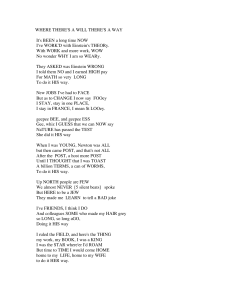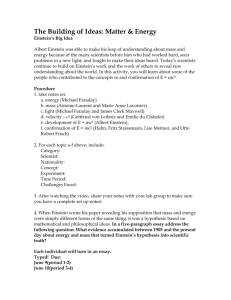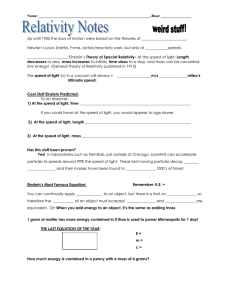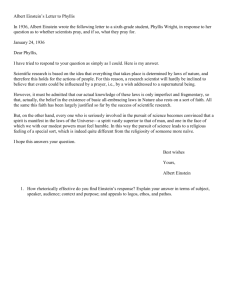10 surprising facts about Einstein
advertisement
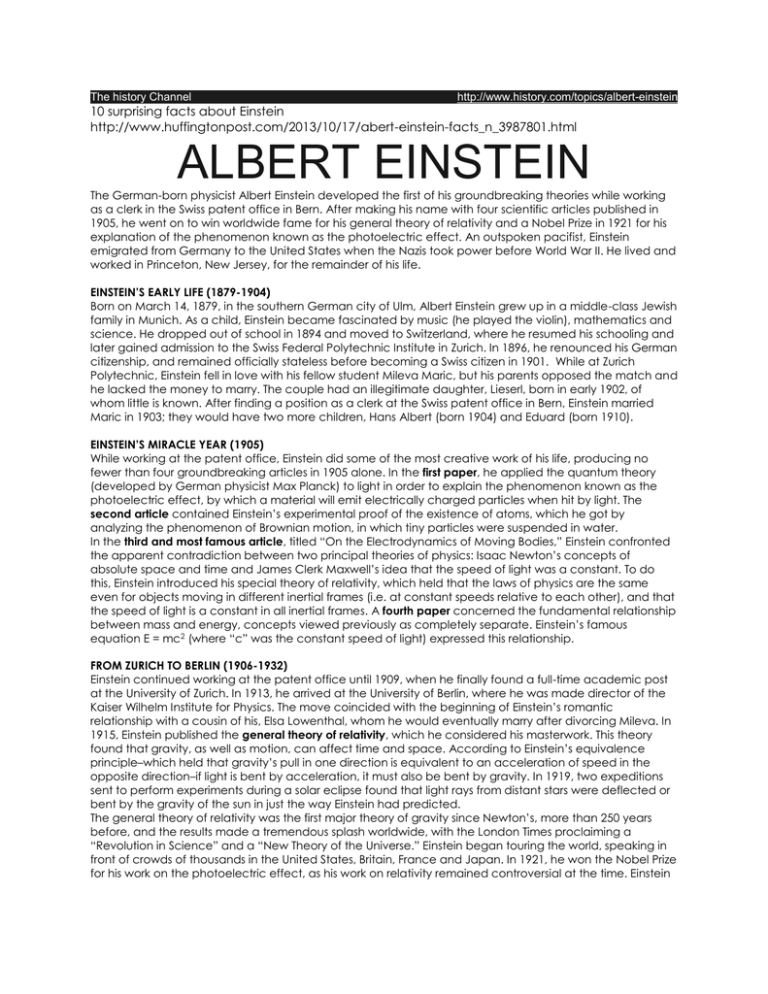
The history Channel http://www.history.com/topics/albert-einstein 10 surprising facts about Einstein http://www.huffingtonpost.com/2013/10/17/abert-einstein-facts_n_3987801.html ALBERT EINSTEIN The German-born physicist Albert Einstein developed the first of his groundbreaking theories while working as a clerk in the Swiss patent office in Bern. After making his name with four scientific articles published in 1905, he went on to win worldwide fame for his general theory of relativity and a Nobel Prize in 1921 for his explanation of the phenomenon known as the photoelectric effect. An outspoken pacifist, Einstein emigrated from Germany to the United States when the Nazis took power before World War II. He lived and worked in Princeton, New Jersey, for the remainder of his life. EINSTEIN’S EARLY LIFE (1879-1904) Born on March 14, 1879, in the southern German city of Ulm, Albert Einstein grew up in a middle-class Jewish family in Munich. As a child, Einstein became fascinated by music (he played the violin), mathematics and science. He dropped out of school in 1894 and moved to Switzerland, where he resumed his schooling and later gained admission to the Swiss Federal Polytechnic Institute in Zurich. In 1896, he renounced his German citizenship, and remained officially stateless before becoming a Swiss citizen in 1901. While at Zurich Polytechnic, Einstein fell in love with his fellow student Mileva Maric, but his parents opposed the match and he lacked the money to marry. The couple had an illegitimate daughter, Lieserl, born in early 1902, of whom little is known. After finding a position as a clerk at the Swiss patent office in Bern, Einstein married Maric in 1903; they would have two more children, Hans Albert (born 1904) and Eduard (born 1910). EINSTEIN’S MIRACLE YEAR (1905) While working at the patent office, Einstein did some of the most creative work of his life, producing no fewer than four groundbreaking articles in 1905 alone. In the first paper, he applied the quantum theory (developed by German physicist Max Planck) to light in order to explain the phenomenon known as the photoelectric effect, by which a material will emit electrically charged particles when hit by light. The second article contained Einstein’s experimental proof of the existence of atoms, which he got by analyzing the phenomenon of Brownian motion, in which tiny particles were suspended in water. In the third and most famous article, titled “On the Electrodynamics of Moving Bodies,” Einstein confronted the apparent contradiction between two principal theories of physics: Isaac Newton’s concepts of absolute space and time and James Clerk Maxwell’s idea that the speed of light was a constant. To do this, Einstein introduced his special theory of relativity, which held that the laws of physics are the same even for objects moving in different inertial frames (i.e. at constant speeds relative to each other), and that the speed of light is a constant in all inertial frames. A fourth paper concerned the fundamental relationship between mass and energy, concepts viewed previously as completely separate. Einstein’s famous equation E = mc2 (where “c” was the constant speed of light) expressed this relationship. FROM ZURICH TO BERLIN (1906-1932) Einstein continued working at the patent office until 1909, when he finally found a full-time academic post at the University of Zurich. In 1913, he arrived at the University of Berlin, where he was made director of the Kaiser Wilhelm Institute for Physics. The move coincided with the beginning of Einstein’s romantic relationship with a cousin of his, Elsa Lowenthal, whom he would eventually marry after divorcing Mileva. In 1915, Einstein published the general theory of relativity, which he considered his masterwork. This theory found that gravity, as well as motion, can affect time and space. According to Einstein’s equivalence principle–which held that gravity’s pull in one direction is equivalent to an acceleration of speed in the opposite direction–if light is bent by acceleration, it must also be bent by gravity. In 1919, two expeditions sent to perform experiments during a solar eclipse found that light rays from distant stars were deflected or bent by the gravity of the sun in just the way Einstein had predicted. The general theory of relativity was the first major theory of gravity since Newton’s, more than 250 years before, and the results made a tremendous splash worldwide, with the London Times proclaiming a “Revolution in Science” and a “New Theory of the Universe.” Einstein began touring the world, speaking in front of crowds of thousands in the United States, Britain, France and Japan. In 1921, he won the Nobel Prize for his work on the photoelectric effect, as his work on relativity remained controversial at the time. Einstein soon began building on his theories to form a new science of cosmology, which held that the universe was dynamic instead of static, and was capable of expanding and contracting. EINSTEIN MOVES TO THE UNITED STATES (1933-39) A longtime pacifist and a Jew, Einstein became the target of hostility in Weimar Germany, where many citizens were suffering plummeting economic fortunes in the aftermath of defeat in the Great War. In December 1932, a month before Adolf Hitler became chancellor of Germany, Einstein made the decision to emigrate to the United States, where he took a position at the newly founded Institute for Advanced Study in Princeton, New Jersey. He would never again enter the country of his birth. By the time Einstein’s wife Elsa died in 1936, he had been involved for more than a decade with his efforts to find a unified field theory, which would incorporate all the laws of the universe, and those of physics, into a single framework. In the process, Einstein became increasingly isolated from many of his colleagues, who were focused mainly on the quantum theory and its implications, rather than on relativity. EINSTEIN’S LATER LIFE (1939-1955) In the late 1930s, Einstein’s theories, including his equation E=mc2, helped form the basis of the development of the atomic bomb. In 1939, at the urging of the Hungarian physicist Leo Szilard, Einstein wrote to President Franklin D. Roosevelt advising him to approve funding for the development of uranium before Germany could gain the upper hand. Einstein, who became a U.S. citizen in 1940 but retained his Swiss citizenship, was never asked to participate in the resulting Manhattan Project, as the U.S. government suspected his socialist and pacifist views. In 1952, Einstein declined an offer extended by David Ben-Gurion, Israel’s premier, to become president of Israel. Throughout the last years of his life, Einstein continued his quest for a unified field theory. Though he published an article on the theory in Scientific American in 1950, it remained unfinished when he died, of an aortic aneurysm, five years later. In the decades following his death, Einstein’s reputation and stature in the world of physics only grew, as physicists began to unravel the mystery of the so-called “strong force” (the missing piece of his unified field theory) and space satellites further verified the principles of his cosmology. DID YOU KNOW? 1. Einstein was slow to talk. "Einstein Syndrome” was coined to describe exceptionally bright people whose speech is delayed. 2. Einstein did NOT flunk math. It's long been rumored that Einstein was a bad student but before age 15 he had already mastered calculus. 3. Einstein’s brain didn’t stay with his body when he died. When Einstein died in 1955, his body was cremated and his ashes scattered, as was his wish. However, before his body was cremated, pathologist Thomas Harvey at Princeton Hospital conducted an autopsy in which he removed Einstein's brain. Rather than putting the brain back in the body, Harvey decided to keep it for study. Harvey did not have permission to keep Einstein's brain, but days later, he convinced Einstein's son that it would help science. Shortly thereafter, Harvey was fired from his position at Princeton because he refused to give up Einstein's brain. For the next four decades, Harvey kept Einstein's chopped-up brain (Harvey had it cut into over 200 pieces) in two mason jars with him as he moved around the country. Every once in a while, Harvey would slice off a piece and send it to a researcher. Finally, in 1998, Harvey returned Einstein's brain to the pathologist at Princeton Hospital. 4. Einstein married his first cousin. After Einstein divorced his first wife, Mileva Maric, in 1919, he married his cousin, Elsa Loewenthal. How closely were they related? Quite close. Elsa was actually related to Albert on both sides of his family. Albert's mother and Elsa's mother were sisters, plus Albert's father and Elsa's father were cousins. 5. Einstein was opposed to the usage of the atomic bomb. Almost immediately after Albert Einstein learned of the atomic bombs use in Japan, he became an advocate for nuclear disarmament. He formed the Emergency Committee of Atomic Scientists and backed Manhattan Project scientist J. Robert Oppenheimer in his opposition to the hydrogen bomb. Einstein's gravitational waves detected in scientific milestone Feb 2016 Gravitational wave In physics, gravitational waves are ripples of compression and stretching of spacetime which propagate as waves, travelling outward from the source. Predicted in 1916 by Albert Einstein on the basis of his theory of general relativity, gravitational waves transport energy as gravitational radiation at the speed of light. WASHINGTON/CAMBRIDGE, Mass., Feb 11, 2016 (Reuters) - Scientists have for the first time detected gravitational waves, ripples in space and time hypothesized by Albert Einstein a century ago, in a landmark discovery announced on Thursday that opens a new window for studying the cosmos. The researchers said they detected gravitational waves coming from two distant black holes extraordinarily dense objects whose existence also was foreseen by Einstein - that orbited one another, spiraled inward and smashed together. They said the waves were the product of a collision between two black holes roughly 30 times the mass of the Sun, located 1.3 billion light years from Earth. "Ladies and gentlemen, we have detected gravitational waves. We did it," said California Institute of Technology physicist David Reitze, triggering applause at a packed news conference in Washington. "It's been a very long road, but this is just the beginning," Louisiana State University physicist Gabriela Gonzalez told the news conference, touting the opening of a new era in astronomy. The scientific milestone was achieved using a pair of giant laser detectors in the United States, located in Louisiana and Washington state, capping a decades-long quest to find these waves. Einstein's gravitational waves "The colliding black holes that produced these gravitational waves created a violent storm in the fabric of space and time, a storm in which time speeded up, and slowed down, and speeded up again, a storm in which the shape of space was bent in this way and that way," Caltech physicist Kip Thorne said. The two laser instruments, which work in unison, are known as the Laser Interferometer Gravitational-Wave Observatory (LIGO). They were able to detect remarkably small vibrations from passing gravitational waves. After detecting the gravitational wave signal, the scientists said they converted it into audio waves and were able to listen to the sounds of the two black holes merging. "We're actually hearing them go thump in the night," Massachusetts Institute of Technology physicist Matthew Evans said. "We're getting a signal which arrives at Earth, and we can put it on a speaker, and we can hear these black holes go, 'Whoop.' There's a very visceral connection to this observation." The scientists said they first detected the gravitational waves last Sept. 14, 2015. "We are really witnessing the opening of a new tool for doing astronomy," MIT astrophysicist Nergis Mavalvala said in an interview. "We have turned on a new sense. We have been able to see and now we will be able to hear as well." Einstein in 1916 proposed the existence of gravitational waves as an outgrowth of his groundbreaking general theory of relativity, which depicted gravity as a distortion of space and time triggered by the presence of matter. But until now scientists had found only indirect evidence of their existence. OPEN THE DOOR Scientists said gravitational waves open a door for a new way to observe the universe and gain knowledge about enigmatic objects like black holes and neutron stars. By studying gravitational waves they also hope to gain insight into the nature of the very early universe, which has remained mysterious. Everything we know about the cosmos stems from electromagnetic waves such as radio waves, visible light, infrared light, X-rays and gamma rays. But because such waves encounter interference as they travel across the universe, they can tell only part of the story. Gravitational waves experience no such barriers, meaning they can offer a wealth of additional information. Black holes, for example, do not emit light, radio waves and the like, but can be studied via gravitational waves. The scientists said that because gravitational waves are so radically different from electromagnetic waves they expect them to reveal big surprises about the universe. Scientists sounded positively giddy over the discovery. "This is the holy grail of science," said Rochester Institute of Technology astrophysicist Carlos Lousto. "The last time anything like this happened was in 1888 when Heinrich Hertz detected the radio waves that had been predicted by James Clerk Maxwell's field-equations of electromagnetism in 1865," added Durham University physicist Tom McLeish. "It is really a truly, truly exciting event," said Abhay Ashtekar, director of Penn State University's Institute for Gravitation and the Cosmos. "It opens a brand new window on the universe." Ashtekar said heavy celestial objects bend space and time but because of the relative weakness of the gravitational force the effect is miniscule except from massive and dense bodies like black holes and neutron stars. He said that when these objects collide, they send out ripples in the curvature of space and time that propagate as gravitational waves. A black hole, a region of space so packed with matter that not even photons of light can escape the force of gravity, was detected for the first time in 1971. Neutron stars are small, about the size of a city, but are extremely heavy, the compact remains of a larger star that died in a supernova explosion. The LIGO observatories are funded by the National Science Foundation, an independent agency of the U.S. government.

